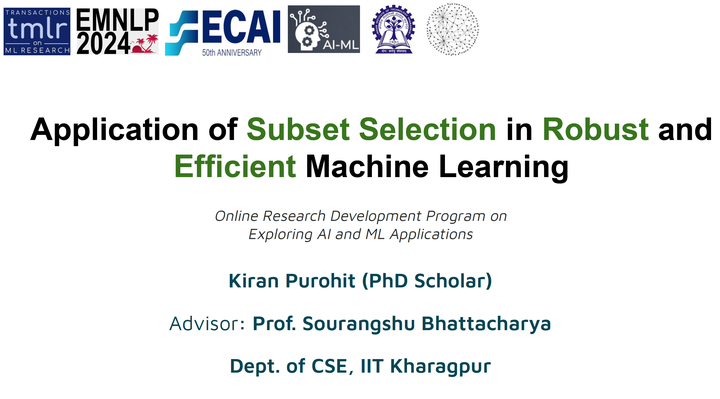Application of Subset Selection in Robust and Efficient Machine Learning @ C. V. Raman Global University (CGU), Odisha 2025

Abstract
Answering reasoning-based complex questions over text and hybrid sources, including tables, is a challenging task. Recent advances in large language models (LLMs) have enabled in-context learning (ICL), allowing LLMs to acquire proficiency in a specific task using only a few demonstration samples (exemplars). A critical challenge in ICL is the selection of optimal exemplars, which can be either task-specific (static) or test-example-specific (dynamic). Static exemplars provide faster inference times and increased robustness across a distribution of test examples. In this paper, we propose an algorithm for static exemplar subset selection for complex reasoning tasks. We introduce a novel exploration method designed to estimate the parameters of the scoring function, which evaluates exemplar subsets without incorporating confidence information. Deep convolutional neural networks (CNNs) have achieved impressive performance in many computer vision tasks. However, their large model sizes require heavy computational resources, making pruning redundant filters from existing pre-trained CNNs an essential task in developing efficient models for resource-constrained devices. Whole-network filter pruning algorithms prune varying fractions of filters from each layer, hence providing greater flexibility. State-of-the-art whole-network pruning methods are either computationally expensive due to the need to calculate the loss for each pruned filter using a training dataset, or use various heuristic / learned criteria for determining the pruning fractions for each layer. We propose a simple and efficient technique for whole-network pruning. Federated Learning systems are increasingly subjected to a multitude of model poisoning attacks from clients. Among these, edge-case attacks that target a small fraction of the input space are nearly impossible to detect using existing defenses, leading to a high attack success rate. We propose an effective defense using an external defense dataset, which provides information about the attack target. The defense dataset contains a mix of poisoned and clean examples, with only a few known to be clean. The proposed method, DataDefense, uses this dataset to learn a poisoned data detector model which marks each example in the defense dataset as poisoned or clean. It also learns a client importance model that estimates the probability of a client update being malicious. The global model is then updated as a weighted average of the client models’ updates. The poisoned data detector and the client importance model parameters are updated using an alternating minimization strategy over the Federated Learning rounds.